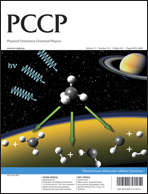Diffractive and reactive scattering of H2 from Ru(0001): experimental and theoretical study
Abstract
We present a combined experimental and theoretical study of the diffraction of H2 from Ru(0001) in the incident energy range 78–150 meV, and a theoretical study of dissociative chemisortpion of H2 in the same system. Pronounced out-of-plane diffraction was observed in the whole energy range studied. The energy dependence of the elastic diffraction intensities was measured along the two main symmetry directions for a fixed parallel translational energy. The data were compared with quantum dynamics calculations performed by using DFT-based, six-dimensional potential energy surfaces calculated with both the PW91 and RPBE functionals, as well as with a functional obtained from a weighted average of both (the MIX functional, which was earlier shown to perform quite well for H2 + Cu(111)). Our results show that the PW91 functional describes the H2 diffraction intensities more accurately than the RPBE and the MIX functionals, although the absolute values of these intensities are overestimated in the calculations. For the reaction probabilities a preference for one or the other functional cannot be given over the entire energy range probed by the sticking experiments. The PW91 functional yields too high reaction probabilities over the entire investigated energy range, but is better than RPBE at low collision energies (<0.1 eV). The RPBE functional gives too low reaction probabilities at low energy and somewhat too high reaction probabilities at high energy, but agrees better with experiment than PW91 for energies >0.1 eV. The results suggest that, in order to get a better description of both H2 diffraction and dissociative chemisorption for this system, a specific reaction parameter functional for H2 + Ru(0001) is needed that is a weighted average of functionals other than PW91 and RPBE. We speculate that differences between the H2 + Ru(0001) system (early and low reaction barrier) and H2 + Cu(111) (late and high reaction barrier) may well lead to fundamentally different specific reaction parameter functionals, and that including a reasonable accurate description of the van der Waals interaction might be important for H2 + Ru(0001) which has barriers localised far away from the surface. Based on our results we advocate new, systematic combined theoretical and experimental studies of H2 interacting with transition metals in early and late barrier systems, with the aim of determining whether specific reaction parameter functionals for these systems might differ in a systematic way.

- This article is part of the themed collection: Molecular Collision Dynamics

 Please wait while we load your content...
Please wait while we load your content...